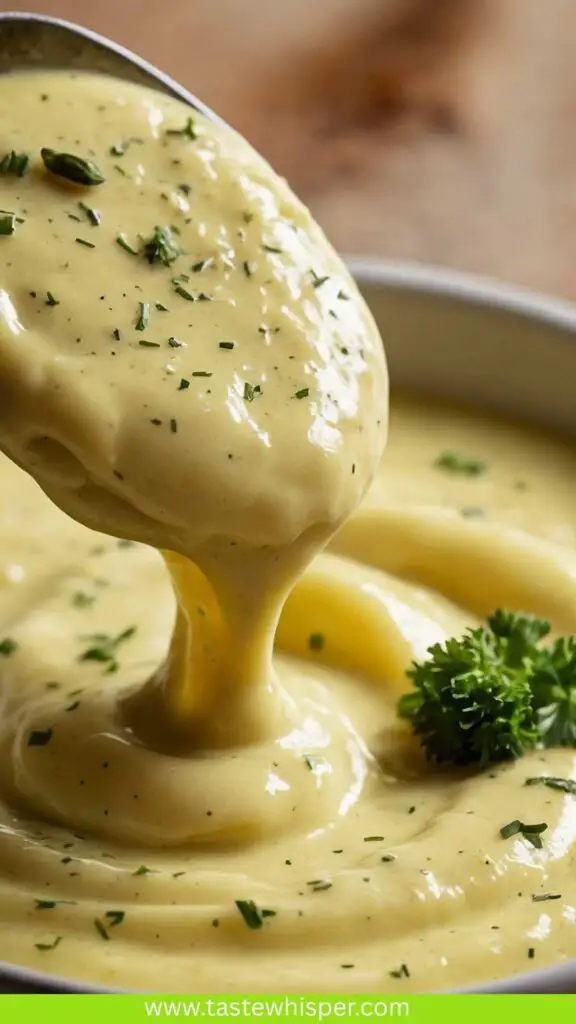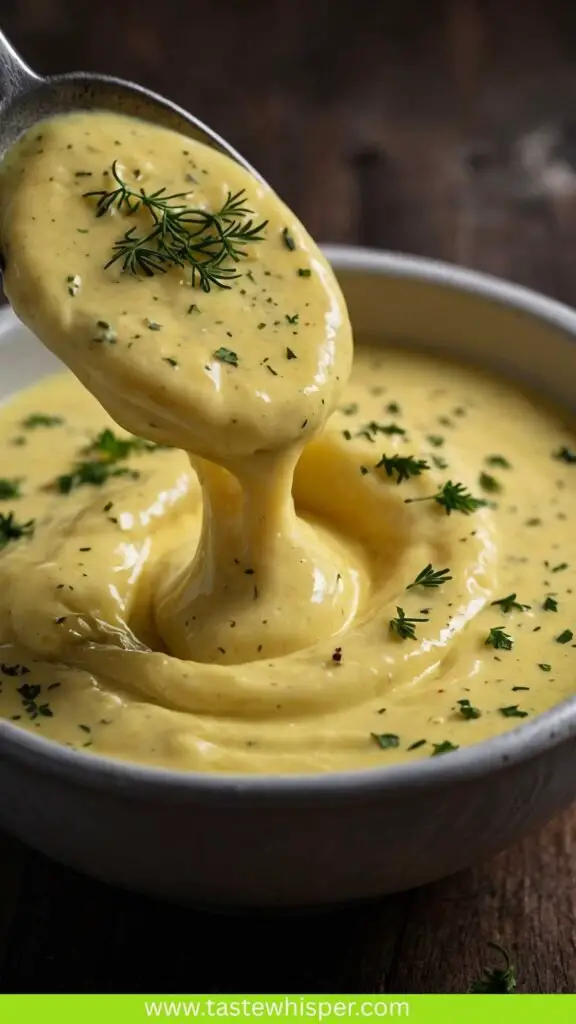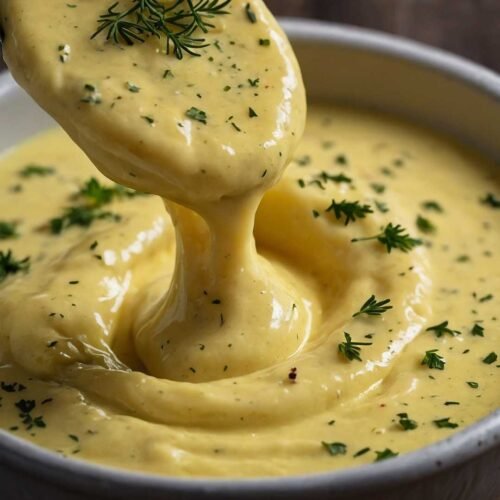There’s something special about the process of making a sauce that feels both intricate and approachable.
Bearnaise sauce has secured a beloved spot in my kitchen, and I feel compelled to share everything I’ve learned about it. Inspired by its rich heritage and delectable flavor, I embarked on a culinary adventure to master this classic French delight.

You’ll Also Like These Recipes
What is Bearnaise Sauce?
Bearnaise sauce is a creamy, buttery sauce that has a distinct herbal flavor. At first glance, you might think it’s just another compound sauce, but there’s a world of taste tucked into every spoonful. Traditionally, it hails from France and serves as a delightful companion for meats, particularly grilled meats.
The heart of Bearnaise lies in its components: egg yolks, clarified butter, vinegar, and fresh herbs. Simply put, it’s a velvety wonder that elevates any dish it touches.
The sauce is often compared to hollandaise, but the key distinction is the inclusion of tarragon and shallots in Bearnaise, which infuse it with an unforgettable aroma and taste.
Why You’ll Love This Bearnaise Sauce
You might wonder why you should dive into Bearnaise sauce. Let me paint the picture for you. Imagine drizzling this golden concoction on a perfectly grilled steak or using it as a sauce for roasted vegetables. Better yet, picture it paired with fresh seafood. Each bite will transport you to a French bistro, and you’ll relish every moment.
The beauty of Bearnaise sauce is not only in its richness but also in its versatility. As someone who enjoys both cooking and sharing experiences around the table, I’m convinced that Bearnaise brings a touch of sophistication to casual meals. It’s a crowd-pleaser that makes you feel fancy without requiring you to don an apron and chef’s hat.
The Ingredients
To craft a top-notch Bearnaise, gather these ingredients:
Infused Vinegar Base
- 1/4 tsp black pepper, coarsely crushed
- 1 1/2 tbsp white wine vinegar
- 2 sprigs tarragon
- 1 small shallot, peeled and finely sliced
- 1 1/2 tbsp dry white wine (avoid fruity or sweet varieties)
- 1/4 tsp fennel seeds, lightly crushed (optional, but offers a lovely hint of anise)
Béarnaise Sauce
- 225g unsalted butter (about 16 tbsp), cut into 1-inch cubes
- 3 egg yolks, at room temperature
- 1/4 tsp finely grated lemon zest (adds freshness)
- 1/4 tsp kosher or cooking salt
- 1/2 tbsp tarragon leaves, finely chopped (for herbal goodness)

Step-by-Step Instructions
Step 1: Prepare the Infused Vinegar Base
Start by combining the black pepper, white wine vinegar, tarragon sprigs, shallot, white wine, and fennel seeds (if using) in a small saucepan. Set the heat to medium and let it simmer gently until reduced by half. This should take about 5-10 minutes. The reduction will create a flavorful base for your sauce.
Step 2: Strain the Mixture
After reducing, strain the mixture through a fine sieve into a bowl. You want to leave behind the solids while keeping that flavorful liquid. This step is crucial; it will ensure your sauce remains silky and smooth.
Step 3: Set Up Your Double Boiler
Fill a saucepan with water and bring it to a gentle simmer. Place a heatproof bowl on top—this is your makeshift double boiler. It’s essential for preventing your eggs from scrambling while cooking.
Step 4: Whisk the Egg Yolks
Add the strained vinegar mixture to the bowl over the simmering water. Toss in the egg yolks and start whisking vigorously. This step is where the magic begins; it’s crucial to whip the yolks continuously until they thicken and become frothy, which takes about 5 minutes.
Step 5: Incorporate the Butter
Once thickened, start adding the cubed butter piece by piece. Let each cube melt into the mixture before adding the next. You’re looking to create a creamy emulsion. Don’t rush this; it’s what gives Bearnaise its luxurious texture!
Step 6: Final Touches
After all the butter is incorporated, add salt, lemon zest, and freshly chopped tarragon. Stir well and taste. Adjust seasoning as needed. You want that perfect balance of saltiness and herbal notes.
Step 7: Serve or Store
Bearnaise sauce should be served immediately, but if you need to hold off on serving, keep it warm over low heat. It can also be stored in a covered container in the fridge for up to a day. Just be mindful of reheating it gently.
Tips & Tricks
Quality Counts: Use high-quality butter and fresh ingredients for the best flavor.
- Keep it Low and Slow: Control the heat when melting butter and whisking yolks. High heat can ruin your sauce.
- Taste as You Go: Adjust seasoning to your personal preference. Lemon zest can brighten flavors!
- Serve Immediately: Best enjoyed fresh. If you need to hold it, keep it over low heat.
- Garnish: A sprinkle of freshly chopped herbs on top adds final flair and freshness.
Nutrition Information
Bearnaise sauce might not be the lightest condiment, but when made with care, it can be less daunting than it seems. On average, a 1-tablespoon serving contains roughly:
- Calories: 100
- Fat: 11g
- Carbohydrates: 1g
- Protein: 1g
Please bear in mind that these values can vary significantly based on the exact ingredients and proportions used.
Can I Store Bearnaise Sauce?
Yes, you can! Bearnaise sauce can be held in the refrigerator for about a day, but the texture may change slightly. If storing, transfer it to a container with a tight lid. Reheat gently in a double boiler or over low heat. Always whisk to return some creaminess to it.
What Can I Serve with Bearnaise Sauce?
Bearnaise sauce shines with various dishes:
- Grilled Meats: Steaks, chicken, or pork chops are simply fantastic with this sauce.
- Fish: Drizzle over grilled or baked fish for a delightful contrast.
- Vegetables: Try it with steamed asparagus or roasted potatoes.
- Eggs: A lovely addition to poached eggs or any egg presentation.
- Corn on the Cob: For a surprising twist, serve it with summer corn.

Variations
If your culinary spirit yearns for exploration, I encourage you to try some delicious variations of Bearnaise sauce.
1. Chili Bearnaise: Stir in finely chopped fresh chili peppers to add a kick.
2. Smoky Bearnaise: Add a touch of smoked paprika for a deep, smoky flavor.
3. Lemon-Dill Bearnaise: Substitute tarragon with fresh dill and add more lemon zest for a fresh twist.
4. Mustard Bearnaise: Whisk in a spoonful of Dijon mustard. It introduces a tangy spice that enlivens the dish.
5. Garlic Bearnaise: Sauté minced garlic in the butter or add roasted garlic for a sweet, caramelized depth.

Bearnaise Sauce
Equipment
- Saucepan, Bowl
Ingredients
Infused Vinegar Base
- 1/4 tsp black pepper coarsely crushed
- 1 1/2 tbsp white wine vinegar
- 2 sprigs tarragon
- 1 small shallot peeled and finely sliced
- 1 1/2 tbsp dry white wine avoid fruity or sweet varieties
- 1/4 tsp fennel seeds lightly crushed (optional, but offers a lovely hint of anise)
Béarnaise Sauce
- 225 g unsalted butter about 16 tbsp, cut into 1-inch cubes
- 3 egg yolks at room temperature
- 1/4 tsp finely grated lemon zest adds freshness
- 1/4 tsp kosher or cooking salt
- 1/2 tbsp tarragon leaves finely chopped (for herbal goodness)
Instructions
Step 1: Prepare the Infused Vinegar Base
- Start by combining the black pepper, white wine vinegar, tarragon sprigs, shallot, white wine, and fennel seeds (if using) in a small saucepan. Set the heat to medium and let it simmer gently until reduced by half. This should take about 5-10 minutes. The reduction will create a flavorful base for your sauce.
Step 2: Strain the Mixture
- After reducing, strain the mixture through a fine sieve into a bowl. You want to leave behind the solids while keeping that flavorful liquid. This step is crucial; it will ensure your sauce remains silky and smooth.
Step 3: Set Up Your Double Boiler
- Fill a saucepan with water and bring it to a gentle simmer. Place a heatproof bowl on top—this is your makeshift double boiler. It’s essential for preventing your eggs from scrambling while cooking.
Step 4: Whisk the Egg Yolks
- Add the strained vinegar mixture to the bowl over the simmering water. Toss in the egg yolks and start whisking vigorously. This step is where the magic begins; it’s crucial to whip the yolks continuously until they thicken and become frothy, which takes about 5 minutes.
Step 5: Incorporate the Butter
- Once thickened, start adding the cubed butter piece by piece. Let each cube melt into the mixture before adding the next. You’re looking to create a creamy emulsion. Don’t rush this; it’s what gives Bearnaise its luxurious texture!
Step 6: Final Touches
- After all the butter is incorporated, add salt, lemon zest, and freshly chopped tarragon. Stir well and taste. Adjust seasoning as needed. You want that perfect balance of saltiness and herbal notes.
Step 7: Serve or Store
- Bearnaise sauce should be served immediately, but if you need to hold off on serving, keep it warm over low heat. It can also be stored in a covered container in the fridge for up to a day. Just be mindful of reheating it gently.
Notes
- Keep it Low and Slow: Control the heat when melting butter and whisking yolks. High heat can ruin your sauce.
- Taste as You Go: Adjust seasoning to your personal preference. Lemon zest can brighten flavors!
- Serve Immediately: Best enjoyed fresh. If you need to hold it, keep it over low heat.
- Garnish: A sprinkle of freshly chopped herbs on top adds final flair and freshness.
Nutrition
Frequently Asked Questions
1. Can I make Bearnaise sauce in advance?
While it’s best served fresh, you can prepare the infused vinegar base ahead of time. The final assembly is best done shortly before serving.
2. Can I freeze Bearnaise sauce?
Freezing is not recommended. The sauce’s emulsion may break down, resulting in a texture that’s hard to revive.
3. Is there a vegan version of Bearnaise sauce?
Yes! You can experiment with vegan butter and aquafaba (the liquid from canned chickpeas) to create a plant-based version.
4. How can I fix a broken Bearnaise sauce?
Whisk in a teaspoon of warm water or a few drops of warm melted butter to help re-emulsify the sauce. Sometimes starting with new egg yolks helps, too.
5. Can you substitute other herbs in Bearnaise sauce?
Absolutely! Although tarragon is traditional, you can experiment with herbs like chervil or basil. Each will impart a different character to the sauce.
Conclusion
Bearnaise sauce might seem intricate at first, but once you dive into its world, you’ll find that making it is a rewarding experience. With its rich, buttery flavor and fresh herbal notes, this sauce can elevate countless dishes. From grilled steaks to diverse vegetables, Bearnaise proves that a proper sauce can redefine a meal.
I invite you to embark on this culinary journey. I assure you, mastering Bearnaise sauce will infuse joy into your cooking and dining experiences. Plus, it’ll make you the star of any gathering. Now, roll up those sleeves and get cooking!


